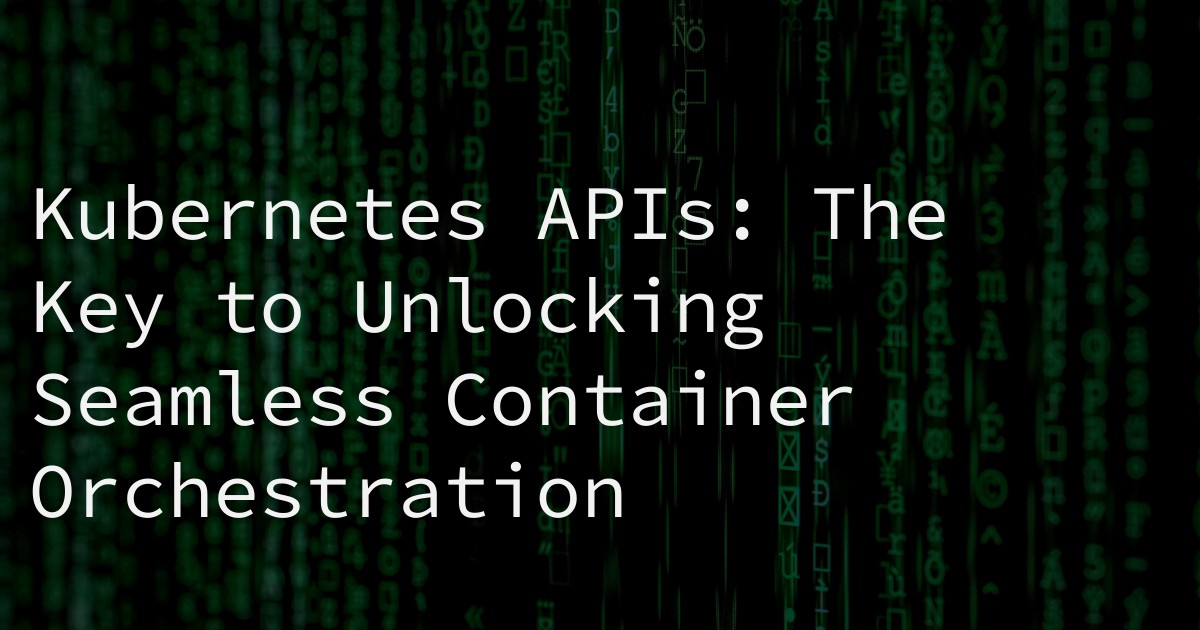
30 Oct Kubernetes APIs: The Key to Unlocking Seamless Container Orchestration
Kubernetes APIs are a crucial component in the world of container orchestration. They provide a standardized way to manage and interact with resources in a Kubernetes cluster, making it easier to deploy and manage containerized applications. In this article, we will explore the various aspects of Kubernetes APIs and their importance in enabling seamless container orchestration. We will also discuss best practices and tips for using Kubernetes APIs, as well as their role in DevOps, DevSecOps, and FinOps practices.
Understanding Kubernetes APIs
Before we dive into the details, let’s first define what Kubernetes APIs are. In simple terms, Kubernetes APIs are interfaces that allow users to interact with a Kubernetes cluster. They act as a bridge between the user and the cluster, providing a way to manage and monitor resources such as pods, services, and deployments.
There are three categories of Kubernetes APIs: core, extension, and custom. Core APIs are the fundamental APIs that are included in every Kubernetes cluster and are responsible for managing core resources. Extension APIs are used to manage additional resources, such as network policies and persistent volumes. Custom APIs are created by users to extend the functionality of Kubernetes.
The Kubernetes API server is the component responsible for managing and exposing APIs. It acts as the front-end for the Kubernetes control plane, receiving and processing API requests from users and other components in the cluster.
Enhancing Container Orchestration with Kubernetes APIs
Kubernetes APIs play a crucial role in enabling seamless container orchestration. By providing a standardized way to manage and interact with resources, they make it easier to deploy and manage containerized applications. Some of the benefits of using Kubernetes APIs include:
- Scalability: Kubernetes APIs allow for easy scaling of resources, making it possible to handle large workloads.
- Flexibility: With Kubernetes APIs, users have the flexibility to customize and extend the functionality of their cluster.
- Portability: Kubernetes APIs make it easier to move applications between different Kubernetes clusters, making them more portable.
Some examples of how Kubernetes APIs can be used to manage and monitor containerized applications include:
- Deploying and scaling applications using the Kubernetes Deployment API.
- Exposing applications to the outside world using the Kubernetes Service API.
- Monitoring and logging application performance using the Kubernetes Metrics API.
Troubleshooting Tips for Kubernetes APIs
While Kubernetes APIs make container orchestration easier, there can be some common issues and errors that users may encounter. Some of these include:
- Authentication errors when trying to access Kubernetes APIs.
- Issues with resource allocation and management.
- Problems with network connectivity and communication between pods.
To troubleshoot these issues, it is important to have a good understanding of the underlying Kubernetes infrastructure. Additionally, using logging and monitoring tools can help identify and resolve issues with Kubernetes APIs.
Best Practices for Using Kubernetes APIs
To make the most out of Kubernetes APIs, it is important to follow some best practices. These include:
- Implementing Role-Based Access Control (RBAC) to secure access to Kubernetes APIs.
- Keeping Kubernetes clusters and API clients up to date to ensure optimal performance and security.
- Versioning and maintaining backward compatibility when using Kubernetes APIs.
Infrastructure as Code with Kubernetes APIs
Kubernetes APIs can also be leveraged for Infrastructure as Code (IaC) practices. This involves using code to manage and provision infrastructure, rather than manually configuring it. Some benefits of using Kubernetes APIs for IaC include:
- Automating deployments and reducing human error.
- Ensuring consistency and reproducibility of infrastructure.
- Enabling version control and collaboration among teams.
Popular IaC tools that utilize Kubernetes APIs include Terraform and Ansible.
Monitoring, Logging, and Tracing with Kubernetes APIs
Kubernetes APIs can also be used for gathering metrics and logs from containerized applications. This allows for real-time visibility and alerting, making it easier to monitor and troubleshoot issues. Additionally, tracing tools and techniques can be used to identify and debug performance issues with Kubernetes APIs.
Networking and Storage with Kubernetes APIs
Kubernetes APIs are also used for networking and storage in a containerized environment. Some of the different types of Kubernetes APIs related to networking and storage include Ingress and Persistent Volumes. These APIs play a crucial role in managing and securing network traffic and data storage in a containerized environment.
Service Mesh with Kubernetes APIs
Service mesh is a popular approach for managing communication between microservices in a Kubernetes cluster. It utilizes Kubernetes APIs to enable features such as load balancing, traffic routing, and service discovery. Some benefits of using service mesh include improving communication between microservices and increasing visibility and control.
Popular service mesh implementations that use Kubernetes APIs include Istio and Linkerd.
Security with Kubernetes APIs
As with any technology, security is a crucial aspect when working with Kubernetes APIs. It is important to secure Kubernetes APIs to prevent unauthorized access and protect sensitive data. Some measures that can be taken to secure Kubernetes APIs include implementing RBAC, network policies, and authentication and authorization mechanisms such as OAuth and JWT.
DevOps, DevSecOps, and FinOps with Kubernetes APIs
Kubernetes APIs play a significant role in implementing DevOps, DevSecOps, and FinOps practices. By automating processes and providing a standardized way to manage infrastructure, they enable teams to collaborate more effectively and optimize costs in a containerized environment. Some tools and methodologies that leverage Kubernetes APIs for achieving these goals include CI/CD pipelines and infrastructure cost management.
Conclusion
In conclusion, Kubernetes APIs are a crucial component in enabling seamless container orchestration and promoting DevOps practices. They provide a standardized way to manage and interact with resources in a Kubernetes cluster, making it easier to deploy and manage containerized applications. By following best practices and utilizing the various features of Kubernetes APIs, teams can achieve efficient and secure container orchestration in their environments.
RELATED ARTICLES:



Sorry, the comment form is closed at this time.